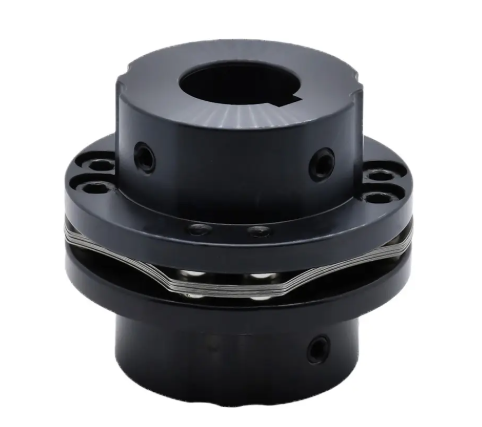Common Diaphragm Coupling Problems and Their Causes
Misalignment Issues
Diaphragm couplings often suffer from misalignment problems that come in three main forms: angular, parallel, and axial. When shafts form an angle with each other, we get angular misalignment. For parallel misalignment, the shafts are simply shifted sideways without any angular component. And axial misalignment happens when there's movement along the coupling's central axis. All these alignment issues accelerate wear on the coupling components, making them work harder and less efficiently until eventually they fail completely. Industry data shows that misaligned couplings plague many manufacturing facilities, shortening equipment lifespan and creating safety hazards during operation. Most plant engineers know this all too well from experience. That's why routine inspections combined with proper alignment adjustments make such a big difference in keeping production lines running smoothly day after day.
Excessive Vibration and Noise
Too much vibration and noise coming from diaphragm couplings usually points to problems with balance or alignment issues. When left unchecked, these problems can wreak havoc on nearby machinery and drive up costs because parts need replacing so often. Industry data shows that around 40% of all machine breakdowns actually stem from vibration problems, which makes tackling them right away pretty important. Companies that get serious about fixing these issues tend to see their repair bills drop significantly while their equipment lasts longer too. Most plants now schedule routine checks every few months and invest in modern monitoring systems that catch small problems before they turn into big headaches down the road.
Diaphragm Fatigue and Breakage
When it comes to diaphragm couplings, fatigue and eventual breakage remain major headaches for maintenance teams. Basically, fatigue happens when the material gets worn down over time from all those repeated stresses during operation. A bunch of things play into how fast this happens. The grade of material matters a lot, along with just how hard the coupling is working under load conditions. Operators should watch out for telltale signs like strange noises coming from the system, increased vibrations, or simply noticing that the coupling isn't performing as well as before. These problems can really mess up equipment performance down the line. Most manufacturers will give specs about expected lifespan and what kind of stress their products can handle. Some companies have started using better materials such as titanium alloys or high-grade stainless steel to make these components last longer. But no matter what's in the spec sheet, regular checkups and following proper operating procedures remain essential practices to avoid getting caught off guard by sudden failures.
Corrosion and Material Degradation
The main causes of corrosion and material breakdown in diaphragm couplings usually come down to environmental stressors and contact with chemicals. When exposed to harsh conditions over time, materials start breaking down which directly impacts how well the coupling works and how long it lasts. Real world experience shows that these problems cut short the useful life of couplings substantially. Case studies from industrial settings confirm this effect in corrosive environments across various sectors. For protection against such degradation, it makes sense to choose diaphragm couplings constructed from materials known for their resistance to corrosion. Applying protective coatings during installation is another smart move many engineers recommend. Regular checks of environmental conditions combined with proper maintenance schedules go a long way toward keeping diaphragm couplings running smoothly longer and avoiding unexpected equipment failures that disrupt operations.
Diagnosing Diaphragm Coupling Failures
Visual Inspection Techniques
Looking at diaphragm couplings visually remains one of the best ways to spot potential problems before they become serious headaches. When someone takes a good look at these components, they can catch obvious signs of trouble such as worn surfaces or cracks in the structure. Many industrial operations depend heavily on these couplings, so regular eye checks help keep everything running smoothly without unexpected breakdowns. Most experienced technicians will tell anyone who'll listen that checking these parts often makes all the difference, particularly when equipment operates under tough conditions where stress builds up over time. Setting up routine visual inspections saves money in the long run because fixing small issues now means avoiding major repairs later down the line.
Vibration Analysis
Looking at vibrations helps figure out what's wrong with diaphragm couplings when they start acting up. Technicians check things like how fast the vibrations happen, how strong they are, and what kind of pattern they follow. This gives them clues about imbalances or alignment issues that might be messing with how well the coupling works. Industry data shows that this method cuts down on machine downtime because it finds problems early without having to tear things apart. Factories have seen real benefits from regular vibration checks. Equipment stays running better for longer periods, which means fewer breakdowns caused by those annoying vibrations we all hate dealing with during production runs.
Torque and Load Testing
Testing for torque and load capacity plays a key role when evaluating how well diaphragm couplings perform under real working conditions. When bolts are either too loose or tightened beyond what's needed, it often results in early coupling failures that compromise entire systems. Getting familiar with manufacturer specs matters a lot here since no two applications are exactly alike. Some situations demand special handling while others work fine with standard procedures. Sticking to those guidelines helps make sure couplings last longer and do their job properly, transferring power without issues in everything from factory automation lines to heavy machinery setups where reliability counts most.
Step-by-Step Fixes for Diaphragm Coupling Issues
Correcting Shaft Misalignment
Getting shaft alignment right makes all the difference when it comes to keeping mechanical systems running smoothly and lasting longer. The first step involves grabbing some good quality alignment gear like laser systems or those old school dial indicators to get an accurate read on where things are out of whack. Once we've got those measurements, the real work begins adjusting those connected shafts so they sit just right inside their coupling. When done properly, this alignment work cuts down on wasted energy, knocks out annoying vibrations, and gives bearings and seals a much needed break from premature wear. Some industry research shows proper alignment can boost system performance anywhere between 20-30% which means real money saved over time both in terms of energy bills and replacement parts.
Replacing Damaged Diaphragms
When replacing a damaged diaphragm, taking things step by step helps prevent additional problems down the road. First things first, make sure all power sources are disconnected before touching anything else. Grab those wrenches and torque drivers to take apart the coupling properly. Once that's done, carefully lift out the old diaphragm and give the surrounding parts a good once over for signs of wear or damage. For replacement parts, go with top notch materials like stainless steel or titanium alloys. These materials stand up better to constant stress and last longer in tough conditions. According to folks who know these systems inside out, investing in quality materials really pays off in terms of system reliability. The right replacement doesn't just fix what's broken it actually makes the whole operation run smoother over time, which means fewer headaches for maintenance crews and less downtime overall.
Addressing Corrosion and Wear
To fight off corrosion and wear in diaphragm couplings, regular cleaning combined with proper protective coatings works best. Start by wiping away dirt and grime with gentle cleaners that won't scratch surfaces, then apply some good quality anti-corrosion lubricant or go for epoxy coatings which stick around longer. Many industrial facilities swear by certain brands after years of testing them out in real world conditions. According to some field data we've seen, keeping up with preventive maintenance actually doubles the lifespan of these components in many cases, which saves money in the long run. Fixing problems early also means fewer unexpected breakdowns during production cycles, so machines keep running smoothly without constant interruptions. That kind of reliability makes all the difference when trying to maintain consistent output levels across shifts.
By following these step-by-step fixes, industries can enhance equipment longevity and performance, boosting overall productivity and reducing maintenance costs. Implementing these strategies not only rectifies existing problems but also safeguards against future diaphragm coupling failures.
Preventative Maintenance Strategies
Good maintenance practices for diaphragm couplings can boost performance while making them last longer too. The most important part? Checking alignment regularly. When couplings get out of alignment, systems start running inefficiently which leads to all sorts of problems down the line. By keeping those shafts properly aligned through regular checks, the whole coupling stays balanced and works better overall. Technicians typically use either laser alignment equipment or traditional dial indicators for these inspections. Plants that stick to this kind of routine maintenance often see big reductions in unexpected breakdowns and repair bills, saving thousands over time on replacement parts and downtime costs.
Getting the lubrication right remains a critical part of any good preventative maintenance plan. For diaphragm couplings specifically, following proper lubrication practices keeps these components running smoothly over time. When done correctly, lubrication cuts down on friction and wear that would otherwise shorten the lifespan of the coupling. Most manufacturers provide detailed guidelines about how often to apply lubricant and which type works best for their particular designs. Many specs will point toward synthetic options since they tend to perform better under tough conditions. The payoff? Equipment runs more reliably day after day, avoiding those costly breakdowns that disrupt operations. Industry experience shows that sticking with recommended lubrication protocols makes all the difference in maintaining consistent performance levels across different applications.
Keeping diaphragm couplings running smoothly requires regular checks on operational parameters. Temperature changes and shifts in load are particularly important to watch closely over time. There are plenty of modern software packages and monitoring systems now on the market that provide live updates and warning signals when something looks off track. Real world experience shows that facilities which implement these monitoring systems tend to catch problems before they become major headaches. When plant managers actually install and use these tech solutions properly, they end up spending less money fixing breakdowns and more time keeping production lines moving without interruptions.
FAQ
What is the primary cause of misalignment issues in diaphragm couplings?
Misalignment issues are caused by angular, parallel, and axial misalignments, often due to poor installation or operational conditions.
How can excessive vibration and noise be reduced in diaphragm couplings?
Reducing excessive vibration and noise involves addressing imbalances and misalignments, along with implementing regular maintenance schedules and diagnostic tools.
What materials can help prevent diaphragm fatigue and breakage?
Using high-quality materials like titanium alloys or stainless steel can prevent fatigue and breakage due to their excellent resistance to operational stresses.
How does corrosion affect diaphragm couplings, and how can it be prevented?
Corrosion degrades diaphragm materials, reducing lifespan. Prevention includes using corrosion-resistant materials and protective coatings.
What is the role of visual inspection in diagnosing diaphragm coupling failures?
Visual inspection helps quickly identify signs of wear or structural damage, allowing timely intervention to prevent system failures.
Table of Contents
- Common Diaphragm Coupling Problems and Their Causes
- Diagnosing Diaphragm Coupling Failures
- Step-by-Step Fixes for Diaphragm Coupling Issues
- Preventative Maintenance Strategies
-
FAQ
- What is the primary cause of misalignment issues in diaphragm couplings?
- How can excessive vibration and noise be reduced in diaphragm couplings?
- What materials can help prevent diaphragm fatigue and breakage?
- How does corrosion affect diaphragm couplings, and how can it be prevented?
- What is the role of visual inspection in diagnosing diaphragm coupling failures?

